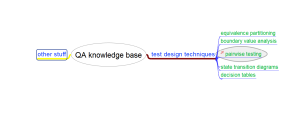Human nature
I think mind maps are still something which is not used to the extent it could be. The idea is very powerful: to use our brain more efficiently. Humans in general memorize visual things, maybe also meaningful sentences, sometimes melodies or body movement sequence (dance) but definitely not numbers nor random strings. There is funny situation in my opinion when passwords are concerned: most of the systems require so called strong password. It is a contemporary myth though: the stronger password they require the higher the probability user will not memorize it. In such case, user will write it down or will try to use the same one for many systems. Does it increase the security? No, it works the opposite way…
Anyway, I like the idea of mind maps as they are truly designed for humans which is rare in today’s systems.
Mind map applications
Mind maps are visual representation of information. They appear as colourful nodes connected with colourful lines.
People in general use it for things like:
– brain storming,
– making fast notes,
– learning things (I tried this way and for me it really works)
I do not want to write about these points – they are more obvious and there is information in internet covering these topics. I would like to show you how to use it in other ways which are less obvious.
There are few applications available (I know Freeplane and Freemind) which implement mind map. I personally prefer Freeplane and all the examples here are done by that application.
Knowledge base
When joining the project very often there is a situation of disspered project know-how. Actually, I have never met a situation of solid knowledge base not to mention expert system on top of it. Information1 is in email, Information2 is on that web page and Information3 is known to that guy over there only. This is the reality in which we often have to start to work.
It is handy to start using mind map as a personal knowledge base, like this one for example:
Every node in Freeplane can be marked with colours and shapes and most importantly can have a link to any resource located both locally and remotely.
OS extra layer
We can go further and use it as an extra layer pu on the top of OS. The specialized layer which concerns our project domain only, perfectly customized… let’s call it Project Map.
Let’s move our knowledge base aside – it will be one of the child nodes in our Project Map.
It will contain things like:
– knowledge base which we continuously expand,
– links to things like scripts, reports, files,
– links to external data
There is no point in losing time on clicking through Window menus, recalling locations of various things. This is distracting and it slows down the work. Everything is now 1 click away.
Take a look at the screenshot:
Again, every node can be clicked and will trigger an action which can be anything from navigating to other mind map to launching an application.
Nice feature Freeplane has is to export to Java applet. Please take a look at this link:
Thus you can also share the mind map with the team or the world just as I did.
Summary
There are many examples in the web. I am sure you can get inspired if this was not the case after reading this post.


